Chhau is basically an art of making tribal masks from a mixture of paper, mud and clay.
It is basically a form of dance using such masks as a prop and wearing colourful and bright clothes. Originated from Mayurbhanj areas of Odisha state, the form of art is quite famous in states like West Bengal and Jharkhand as well.
Lately, cafes like Pagdandi are providing platforms and encouraging artisans to take up workshops and teach others the ancient tribal art Chhau Mask- making. Furthermore, the artisans were also allowed to sell their existing work, such that they are boosted to promote art form and people also get aware of the same.
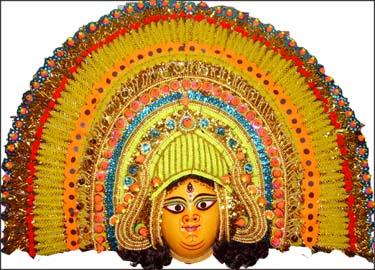
The Royal Prop
Chhau has been popularly known among people for its dance form and the masks have not been into much of a limelight lately. Hence, it is challenging for the artisans to create their own identity and space in the market.
Talking about the dance form, it is performed in the months of March or April marking the end of Chaitra. The dance form intents to drive away negativity from the tribe and promoting positivity and optimism in people.
Epics such as Ramayana, Mahabharata and Purana have been enacted and expressed through this dance form. As such masks of characters like Ravana, Goddess Durga, and lord Ganesha are evident.
The dance begins with beats of drums which encourages the tribe to rejoice and celebrate in great pomp and joy along with colourful costumes.
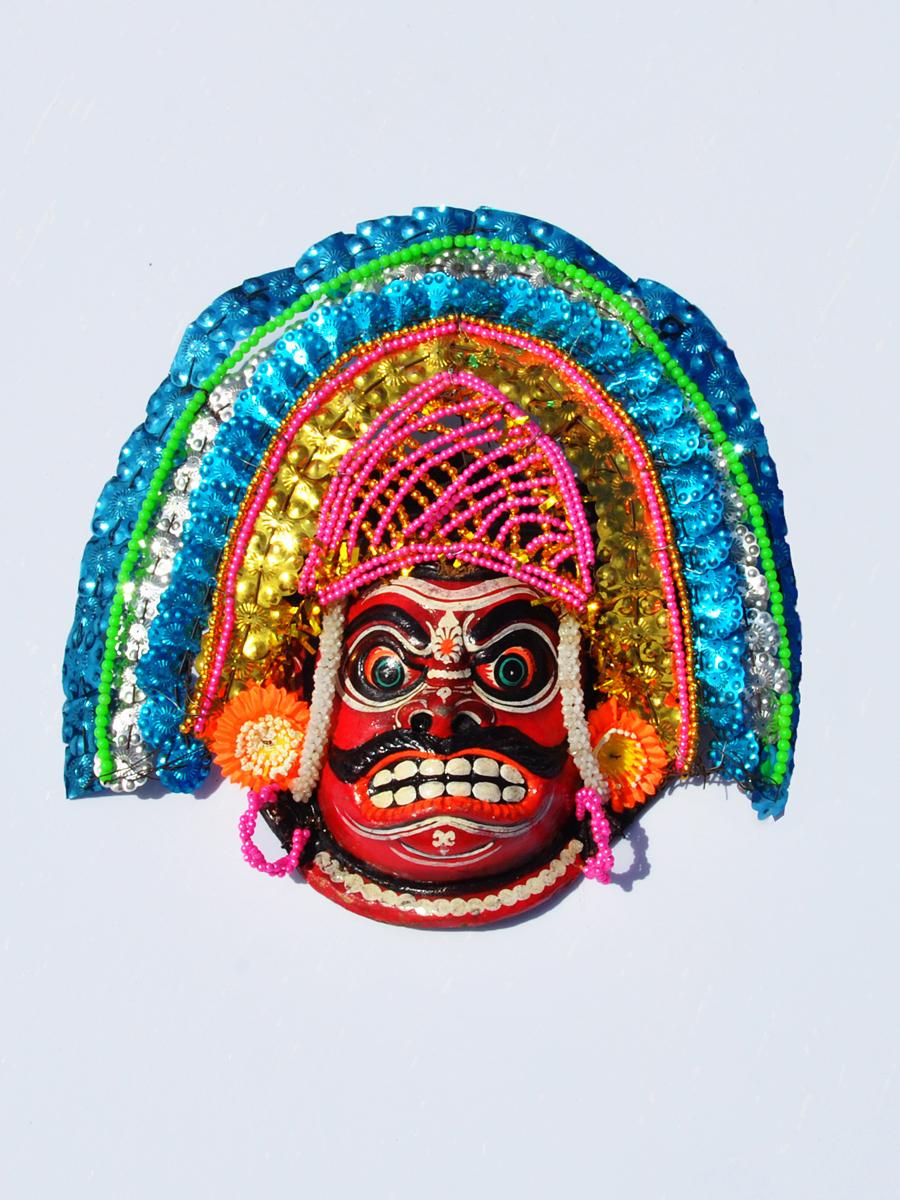
Ravana’s Anger
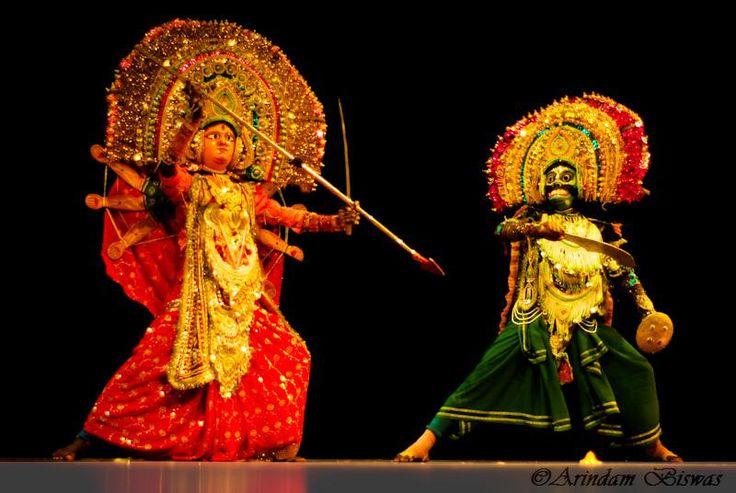
Hail Goddess Durga!
Chhau mainly focuses on portraying mythological characters, but lately college students have improvised on their versions with the help of the artisans to raise awareness about social concerns like women empowerment, equality and rape. These modernized versions are being liked and appreciated by schools and colleges all over the globe.
This dance form also is being promoted as heritage art culture and UNICEF had sponsored one of such acts in the international cultural fests hosted by the United Nations.
This is the second famous dance form after Odissi from the East.
The dance form is as bold in its dramatization as the mask being used in it. From the bold usage of colours to the bold facial description given to the masks raise the goosebumps on the viewer’s skin!
Many art collectors display these tribal collectibles in the form of showpieces in their homes.
There are three versions of this tribal dance form.
One is The Seraikella version which mainly originates from Jharkhand, which involves excessive usage of masks in their dance acts and dramatizations. These dance forms are ferocious and loud in nature. Also the usage of loud drums can be viewed to a large extent.
The Purulia version belongs to West Bengal, which involves usage of more feminine characters like that of Godess Kali or that of Durga and various other versions in their staged acts. Here also there are extensive usage of masks with loud drums. But, this version is different as ladies dance in huge numbers by making a siren- like sound from their mouth by rolling back their tongues.
This version is so bold that even police do not dare to intervene for security purposes.
Purulia version displays more of demon killing by our goddesses portraying the win of good over evil in the society.
Finally there is the Mayurbhanj version which does not involve the usage of masks and believes in pure dancing and creating an impact with human expressions.
Unlike the previous versions, it is not bold or loud but is subtle enough to create a treat for the eyes of the viewer.

Seraikella version
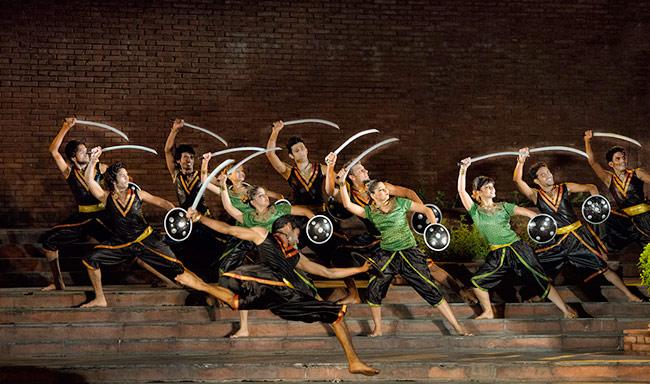
Mayurbhanj’s Warrior style
Though the Mayurbhanj tribe does not use masks, the performances still take away your breath and raise your goosebumps through their performances and finesse. These acts are more of warrior dances or warrior-centric performances portraying the valiance and strenghth of erstwhile Odisha also known as Kalinga, the kingdom of King Ashoka.
Though these dance forms have not been popular in the past, these are being encouraged by cultural societies globally as also dance competitions or dance reality shows which are aired on the television or Youtube.
Chhau dance forms are also being modified into street dance forms or street plays for making others aware of the culture.
Even dance schools and institutes are promoting such tribal dance and art forms in their syllabus.
Coming back to the masks, exhibitions and fairs are being hosted to provide the artisans a platform to improve their livelihood. And some of the artists are hosting workshops for mask making at various venues that kids and adults both learn this ancient and tribal art of mask making and keep the art alive in their modern modifications.
There are Government regulated art emporiums or galleries where such art collectibles are readily available for purchase or gifting. The masks are a colorful treat to the eyes which are also believed to ward off negative energies just like a dreamcatcher wards of negative dreams.
Art collectors also believe it to be a possible lucky charm and an equal Indian Feng Shui. Thus promoting Indian exports for such Masks
Though a not so popular form of art like others, Chhau is still making its presence felt among the others through prominent art collectors, artists and artisans, who are taking the efforts to travel and teach the art to others and raising the awareness about the tribal culture as well.
Chhau also intends to influence other masked dance forms like that of the Tibetan mask dance performed every year in the Tibetan carnival hosted in Shimla and Manali.
Chhau also marks the beginning of the Odia new year which is 1st of April occurring every year in the community halls of Odia Samaj in almost every city or town around the globe.
So, whenever one notices a tribal Indian mask or a Warrior dance, they are going to imagine Chhau in their minds.

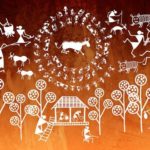
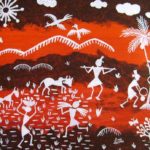
What do you think?